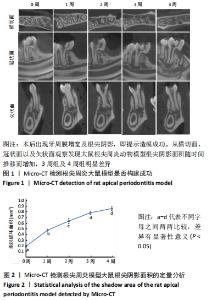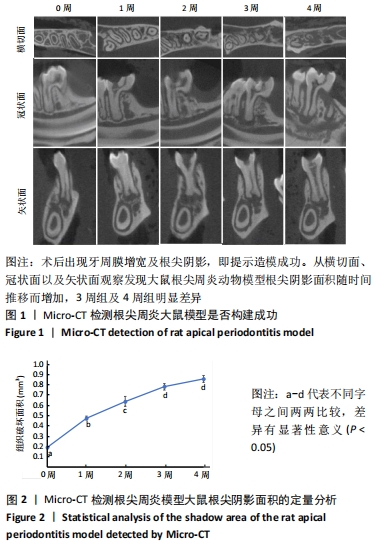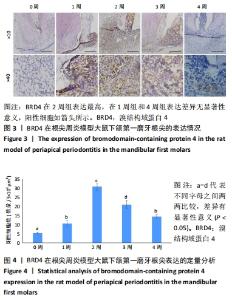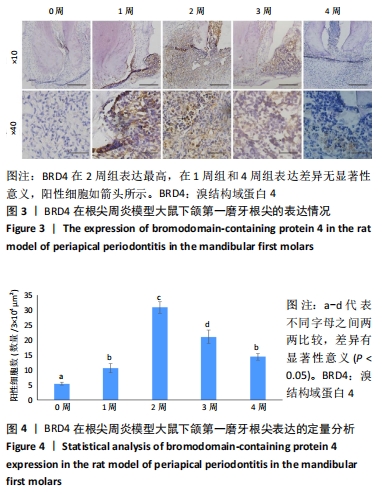Chinese Journal of Tissue Engineering Research ›› 2022, Vol. 26 ›› Issue (14): 2167-2171.doi: 10.12307/2022.478
Previous Articles Next Articles
Changes in the expression of bromodomain-containing protein 4, an epigenetic molecule, in a rat model of chronic periapical periodontitis
Xu Yinghua1, Jiang Long2, Shi Chun3
- 1Pudong New Area Eye Disease and Dental Disease Prevention & Treatment Center, Shanghai 200120, China; 2Zhongshan College of Dalian Medical University, Dalian 116044, Liaoning Province, China; 3School of Stomatology, Dalian Medical University, Dalian 116044, Liaoning Province, China
-
Received:2021-06-09Revised:2021-06-10Accepted:2021-07-28Online:2022-05-18Published:2021-12-21 -
Contact:Shi Chun, Master, Lecturer, School of Stomatology, Dalian Medical University, Dalian 116044, Liaoning Province, China -
About author:Xu Yinghua, Master, Associate chief physician, Pudong New Area Eye Disease and Dental Disease Prevention & Treatment Center, Shanghai 200120, China -
Supported by:Discipline Leader Training Program of the Health System in Pudong New Area, No. PWRd2017-13 (to XYH); the Natural Science Foundation of Liaoning Province, No. 20180550564 (to SC)
CLC Number:
Cite this article
Xu Yinghua, Jiang Long, Shi Chun. Changes in the expression of bromodomain-containing protein 4, an epigenetic molecule, in a rat model of chronic periapical periodontitis[J]. Chinese Journal of Tissue Engineering Research, 2022, 26(14): 2167-2171.
share this article
Add to citation manager EndNote|Reference Manager|ProCite|BibTeX|RefWorks
| [1] BEST S, AMMONS CL, KARUNANAYAKE GA, et al. Outcome Assessment of Teeth with Necrotic Pulps and Apical Periodontitis Treated with Long-term Calcium Hydroxide. J Endod. 2021;47(1):11-18. [2] CORAZZA BJM, MARTINHO FC, KHOURY RD, et al. Clinical influence of calcium hydroxide and N-acetylcysteine on the levels of resolvins E1 and D2 in apical periodontitis. Int Endod J. 2021;54(1):61-73. [3] HUANG L, WU H, WU Y, et al. Pcsk9 Knockout Aggravated Experimental Apical Periodontitis via LDLR. J Dental Res. 2021:220345211015128. [4] KARAMIFAR K, TONDARI A, SAGHIRI MA. Endodontic Periapical Lesion: An Overview on the Etiology, Diagnosis and Current Treatment Modalities. Eur Endod J. 2020;5(2):54-67. [5] KARTEVA T, MANCHOROVA-VELEVA N. The Role of the Immune Response in Chronic Marginal and Apical Periodontitis. Folia Medica. 2020;62(2):238-243. [6] KÜCHLER EC, HANNEGRAF ND, LARA RM, et al. Investigation of Genetic Polymorphisms in BMP2, BMP4, SMAD6, and RUNX2 and Persistent Apical Periodontitis. J Endod. 2021;47(2):278-285. [7] MACHADO FP, KHOURY RD, TOIA CC, et al. Primary versus post-treatment apical periodontitis: microbial composition, lipopolysaccharides and lipoteichoic acid levels, signs and symptoms. Clin Oral Invest. 2020;24(9): 3169-3179. [8] PARK OJ, JEONG MH, LEE EH, et al. A Pilot Study of Chronological Microbiota Changes in a Rat Apical Periodontitis Model. Microorganisms. 2020;8(8):1174. [9] POORNIMA L, RAVISHANKAR P, ABBOTT PV, et al. Impact of root canal treatment on high-sensitivity C-reactive protein levels in systemically healthy adults with apical periodontitis - a preliminary prospective, longitudinal interventional study. Int Endod J. 2021;54(4):501-508. [10] SHEN Z, SILVA RM. MicroRNAs: emerging players in apical periodontitis. J Appl Oral Sci. 2021;29:e20201058. [11] LOGANATHAN SN, TANG N, FLEMING JT, et al. BET bromodomain inhibitors suppress EWS-FLI1-dependent transcription and the IGF1 autocrine mechanism in Ewing sarcoma. Oncotarget. 2016;7(28):43504-43517. [12] JACQUES C, LAVAUD M, GEORGES S, et al. BET bromodomains’ functions in bone-related pathologies. Epigenomics. 2020;12(2):127-144. [13] CAPUTO VS, TRASANIDIS N, XIAO X, et al. Brd2/4 and Myc regulate alternative cell lineage programmes during early osteoclast differentiation in vitro. iScience. 2021;24(1):101989. [14] JIANG Y, ZHU L, ZHANG T, et al. BRD4 has dual effects on the HMGB1 and NF-κB signalling pathways and is a potential therapeutic target for osteoarthritis. Biochimica et biophysica acta. Mol Basis Dis. 2017;1863(12):3001-3015. [15] WANG K, ZHAO Z, WANG X, et al. BRD4 induces osteogenic differentiation of BMSCs via the Wnt/β-catenin signaling pathway. Tissue Cell. 2021;72: 101555. [16] HUANG Z, YANG R, ZHANG L, et al. BRD4 inhibition alleviates mechanical stress-induced TMJ OA-like pathological changes and attenuates TREM1-mediated inflammatory response. Clin Epigenetics. 2021;13(1):10. [17] WANG J, HU J, CHEN X, et al. BRD4 inhibition regulates MAPK, NF-κB signals, and autophagy to suppress MMP-13 expression in diabetic intervertebral disc degeneration. FASEB J. 2019;33(10):11555-11566. [18] DONG X, HU X, BAO Y, et al. Brd4 regulates NLRC4 inflammasome activation by facilitating IRF8-mediated transcription of Naips. J Cell Biol. 2021;220(3): e202005148. [19] WU T, KAMIKAWA YF, DONOHOE ME. Brd4’s Bromodomains Mediate Histone H3 Acetylation and Chromatin Remodeling in Pluripotent Cells through P300 and Brg1. Cell Rep. 2018;25(7):1756-1771. [20] NIU N, SHAO R, YAN G, et al. Bromodomain and Extra-terminal (BET) Protein Inhibitors Suppress Chondrocyte Differentiation and Restrain Bone Growth. J Biol Chem. 2016;291(52):26647-26657. [21] WANG FS, CHEN YS, KO JY, et al. Bromodomain Protein BRD4 Accelerates Glucocorticoid Dysregulation of Bone Mass and Marrow Adiposis by Modulating H3K9 and Foxp1. Cells. 2020;9(6):1500. [22] HONG J, LI S, MARKOVA DZ, et al. Bromodomain-containing protein 4 inhibition alleviates matrix degradation by enhancing autophagy and suppressing NLRP3 inflammasome activity in NP cells. J Cell Physiol. 2020; 235(7-8):5736-5749. [23] CAREY HA, HILDRETH BE, 3RD, GEISLER JA, et al. Enhancer variants reveal a conserved transcription factor network governed by PU.1 during osteoclast differentiation. Bone Res. 2018;6:8. [24] PARADISE CR, GALVAN ML, KUBROVA E, et al. The epigenetic reader Brd4 is required for osteoblast differentiation. J Cell Physiol. 2020;235(6):5293-5304. [25] WIJNEN AJ, WESTENDORF JJ. Epigenetics as a New Frontier in Orthopedic Regenerative Medicine and Oncology. J Orthop Res. 2019;37(7):1465-1474. [26] MING D, XINXIN Y, WANFANG C, et al. Osteopontin Promotes Bone Destruction in Periapical Periodontitis by Activating the NF-κB Pathway. Cell Physiol Biochem. 2018;49(3):884-898. [27] SIRIN DA, OZCELIK F, ERSAHAN S, et al. The importance of inflammatory biomarkers, IL-6 and PAPP-A, in the evaluation of asymptomatic apical periodontitis. Odontology. 2021;109(1):250-258. [28] VELOSO P, FERNÁNDEZ A, TERRAZA-AGUIRRE C, et al. Macrophages skew towards M1 profile through reduced CD163 expression in symptomatic apical periodontitis. Clin Oral Invest. 2020;24(12):4571-4581. [29] DE ROSSI A, HUAMÁN SD, LEÓN JE, et al. Fibroblast growth factor receptor 2 expression in apical periodontitis in mice. Int Endod J. 2020;53(8):1111-1119. [30] BARBOSA-RIBEIRO M, ARRUDA-VASCONCELOS R, LOUZADA LM, et al. Microbiological analysis of endodontically treated teeth with apical periodontitis before and after endodontic retreatment. Clin Oral Invest. 2021;25(4):2017-2027. [31] BARCELOS RCS, ROSA HZ, ROVERSI K, et al. Apical periodontitis induces changes on oxidative stress parameters and increases Na(+)/K(+)-ATPase activity in adult rats. Arch Oral Biol. 2020;118:104849. [32] TALPAZ M, KILADJIAN JJ. Fedratinib, a newly approved treatment for patients with myeloproliferative neoplasm-associated myelofibrosis. Leukemia. 2021; 35(1):1-17. [33] DEEPAK V, WANG B, KOOT D, et al. In silico design and bioevaluation of selective benzotriazepine BRD4 inhibitors with potent antiosteoclastogenic activity. Chem Biol Drug Design. 2017;90(1):97-111. [34] SU Y, SONG X, TENG J, et al. Mesenchymal stem cells-derived extracellular vesicles carrying microRNA-17 inhibits macrophage apoptosis in lipopolysaccharide-induced sepsis. Int Immunopharmacol. 2021;95:107408. [35] FERNÁNDEZ A, VELOSO P, ASTORGA J, et al. Epigenetic regulation of TLR2-mediated periapical inflammation. Int Endod J. 2020;53(9):1229-1237. [36] FREIRE MS, OLIVEIRA NG, LIMA SMF, et al. IL-4 absence triggers distinct pathways in apical periodontitis development. J Proteomics. 2021;233:104080. [37] GOLDMAN E, REICH E, ROSHIHOTZKI B, et al. A Mouse Model for Studying the Development of Apical Periodontitis with Age. Cells. 2021;10(3):671. [38] MING D, HAIWEI J, MEINA Z, et al. The potential effect of Bruton’s tyrosine kinase in refractory periapical periodontitis. Biomed Pharmacother. 2019; 112:108710. [39] DEY A, YANG W, GEGONNE A, et al. BRD4 directs hematopoietic stem cell development and modulates macrophage inflammatory responses. EMBO J. 2019;38(7):e100293. [40] ZHU W, WU RD, LV YG, et al. BRD4 blockage alleviates pathological cardiac hypertrophy through the suppression of fibrosis and inflammation via reducing ROS generation. Biomed Pharmacother. 2020;121:109368. [41] REN Y, ZHANG Y, WANG Z, et al. Role of Brd4 in the production of inflammatory cytokines in mouse macrophages treated with titanium particles. Can J Physiol Pharmacol. 2019;97(11):1028-1034. [42] BAUD’HUIN M, LAMOUREUX F, JACQUES C, et al. Inhibition of BET proteins and epigenetic signaling as a potential treatment for osteoporosis. Bone. 2017; 94:10-21. [43] GORVIN CM, LOH NY, STECHMAN MJ, et al. Mice with a Brd4 Mutation Represent a New Model of Nephrocalcinosis. J Bone Miner Res. 2019;34(7): 1324-1335. [44] BADRELDIN AA, BAGHERI L, ZHANG B, et al. Relative mRNA and protein stability of epigenetic regulators in musculoskeletal cell culture models. Gene. 2021;766:145032. [45] COLLINS TA, HATTERSLEY MM, YATES J, et al. Translational Modeling of Drug-Induced Myelosuppression and Effect of Pretreatment Myelosuppression for AZD5153, a Selective BRD4 Inhibitor. CPT Pharmacometrics Syst Pharmacol. 2017;6(6):357-364. [46] REID S, FINE N, BHOSLE VK, et al. Inhibition of BRD4 Reduces Neutrophil Activation and Adhesion to the Vascular Endothelium Following Ischemia Reperfusion Injury. Int J Mol Sci. 2020;21(24):9620. [47] GHAYOR C, GJOKSI B, DONG J, et al. N,N Dimethylacetamide a drug excipient that acts as bromodomain ligand for osteoporosis treatment. Sci Rep. 2017;7: 42108. |
| [1] | Wang Jianping, Zhang Xiaohui, Yu Jinwei, Wei Shaoliang, Zhang Xinmin, Xu Xingxin, Qu Haijun. Application of knee joint motion analysis in machanism based on three-dimensional image registration and coordinate transformation [J]. Chinese Journal of Tissue Engineering Research, 2022, 26(在线): 1-5. |
| [2] | Tan Xinfang, Guo Yanxing, Qin Xiaofei, Zhang Binqing, Zhao Dongliang, Pan Kunkun, Li Yuzhuo, Chen Haoyu. Effect of uniaxial fatigue exercise on patellofemoral cartilage injury in a rabbit [J]. Chinese Journal of Tissue Engineering Research, 2022, 26(在线): 1-6. |
| [3] | Bao Xianguo, Gao Zengxin, Wu Zhanpo, Chen Youmin, Cheng Qinghua, Lu Haitao, Guo Changzheng, Xu Shuai. Correlation between lumbar posterior muscle and local kyphosis in patients with degenerative thoracolumbar kyphosis [J]. Chinese Journal of Tissue Engineering Research, 2022, 26(9): 1418-1423. |
| [4] | Zhang Haobo, Zhao Yunan, Yang Xuejun. Role and therapeutic implications of pyroptosis in intervertebral disc degeneration [J]. Chinese Journal of Tissue Engineering Research, 2022, 26(9): 1445-1451. |
| [5] | Jing Jinpeng, Zhang Yue, Liu Xiaomin, Liu Yi. Traditional Chinese medicine injection for promoting blood circulation in prevention of deep vein thrombosis after orthopedic surgery: network meta-analysis [J]. Chinese Journal of Tissue Engineering Research, 2022, 26(9): 1467-1476. |
| [6] | Li Huo, Wang Peng, Gao Jianming, Jiang Haoran, Lu Xiaobo, Peng Jiang. Relationship between revascularization and internal microstructure changes in osteonecrosis of the femoral head [J]. Chinese Journal of Tissue Engineering Research, 2022, 26(9): 1323-1328. |
| [7] | Gu Zhengqiu, Xu Fei, Wei Jia, Zou Yongdi, Wang Xiaolu, Li Yongming. Exploratory study on talk test as a measure of intensity in blood flow restriction training [J]. Chinese Journal of Tissue Engineering Research, 2022, 26(8): 1154-1159. |
| [8] | Kong Yamin, Yan Juntao, Ma Bingxiang, Li Huawei. Massage vibration intervenes with MyoD expression and proliferation and differentiation of muscle satellite cells in rats with sciatic nerve injury [J]. Chinese Journal of Tissue Engineering Research, 2022, 26(8): 1160-1166. |
| [9] | Wu Cong, Jia Quanzhong, Liu Lun. Relationship between transforming growth factor beta1 expression and chondrocyte migration in adult articular cartilage after fragmentation [J]. Chinese Journal of Tissue Engineering Research, 2022, 26(8): 1167-1172. |
| [10] | Wang Baojuan, Zheng Shuguang, Zhang Qi, Li Tianyang. Miao medicine fumigation can delay extracellular matrix destruction in a rabbit model of knee osteoarthritis [J]. Chinese Journal of Tissue Engineering Research, 2022, 26(8): 1180-1186. |
| [11] | Lü Yiyan, Li Hanbing, Ma Xiaoqing, Zhang Han, Zhang Yuhang, Li Genlin. Establishment and characteristic analysis of interior heat and diabetes mouse model using compound factors [J]. Chinese Journal of Tissue Engineering Research, 2022, 26(8): 1187-1193. |
| [12] | Li Zhiyi, He Pengcheng, Bian Tianyue, Xiao Yuxia, Gao Lu, Liu Huasheng. Bibliometric and visualized analysis of ferroptosis mechanism research [J]. Chinese Journal of Tissue Engineering Research, 2022, 26(8): 1202-1209. |
| [13] | Xiang Xinjian, Liu Fang, Wu Liangliang, Jia Daping, Tao Yue, Zhao Zhengnan, Zhao Yu. High-dose vitamin C promotes the survival of autologous fat transplantation in rats [J]. Chinese Journal of Tissue Engineering Research, 2022, 26(8): 1242-1246. |
| [14] | Zhu Chan, Han Xuke, Yao Chengjiao, Zhang Qiang, Liu Jing, Shao Ming. Acupuncture for Parkinson’s disease: an insight into the action mechanism in animal experiments [J]. Chinese Journal of Tissue Engineering Research, 2022, 26(8): 1272-1277. |
| [15] | Tian Chuan, Zhu Xiangqing, Yang Zailing, Yan Donghai, Li Ye, Wang Yanying, Yang Yukun, He Jie, Lü Guanke, Cai Xuemin, Shu Liping, He Zhixu, Pan Xinghua. Bone marrow mesenchymal stem cells regulate ovarian aging in macaques [J]. Chinese Journal of Tissue Engineering Research, 2022, 26(7): 985-991. |
| Viewed | ||||||
|
Full text |
|
|||||
|
Abstract |
|
|||||



